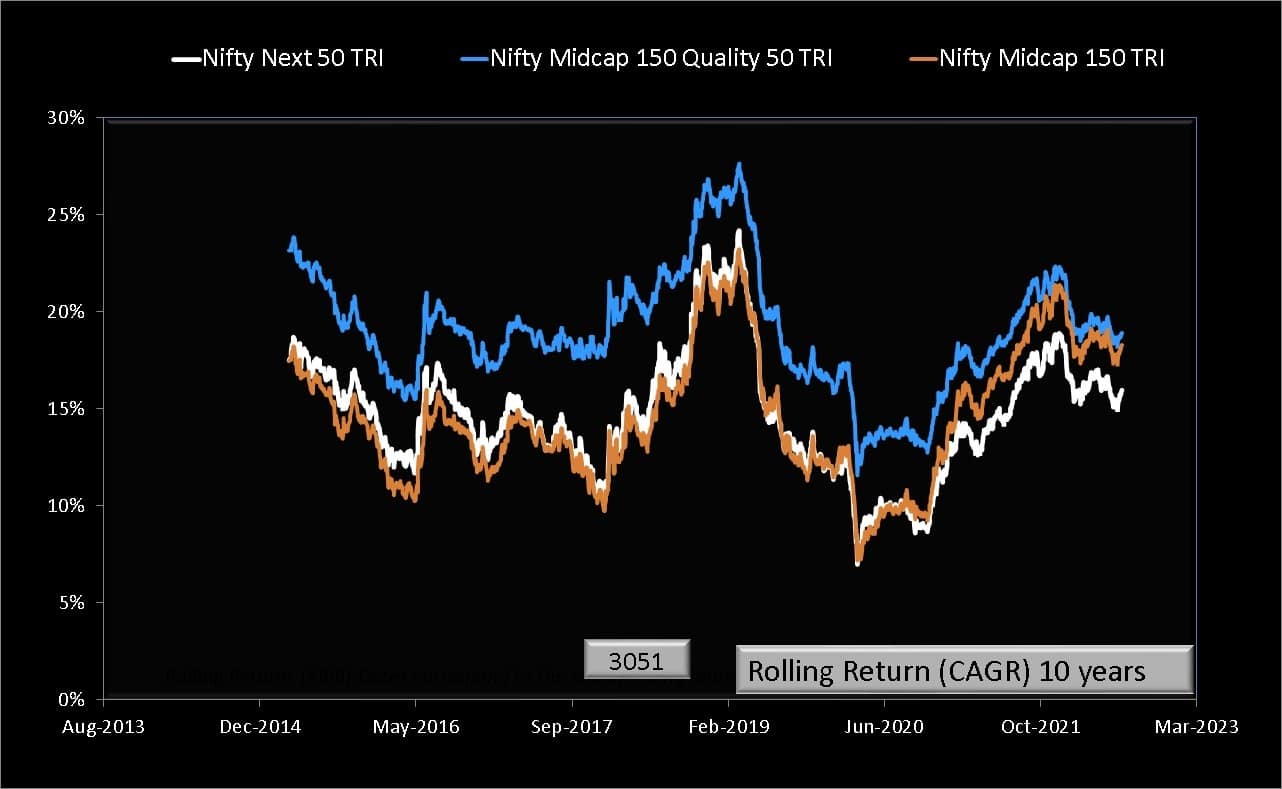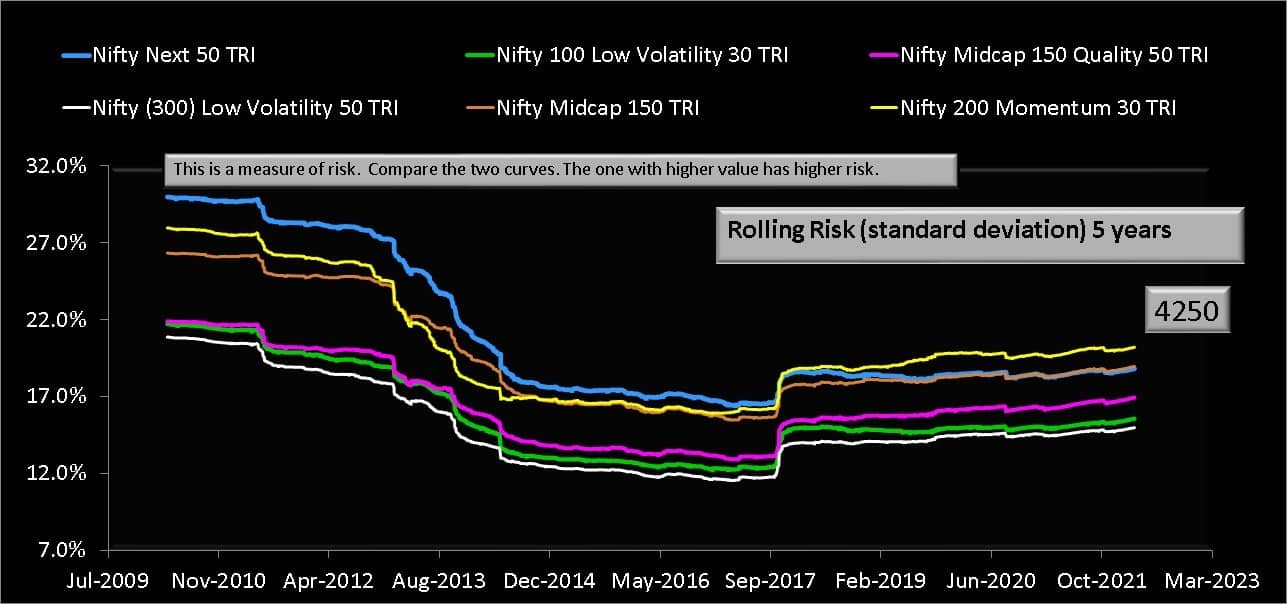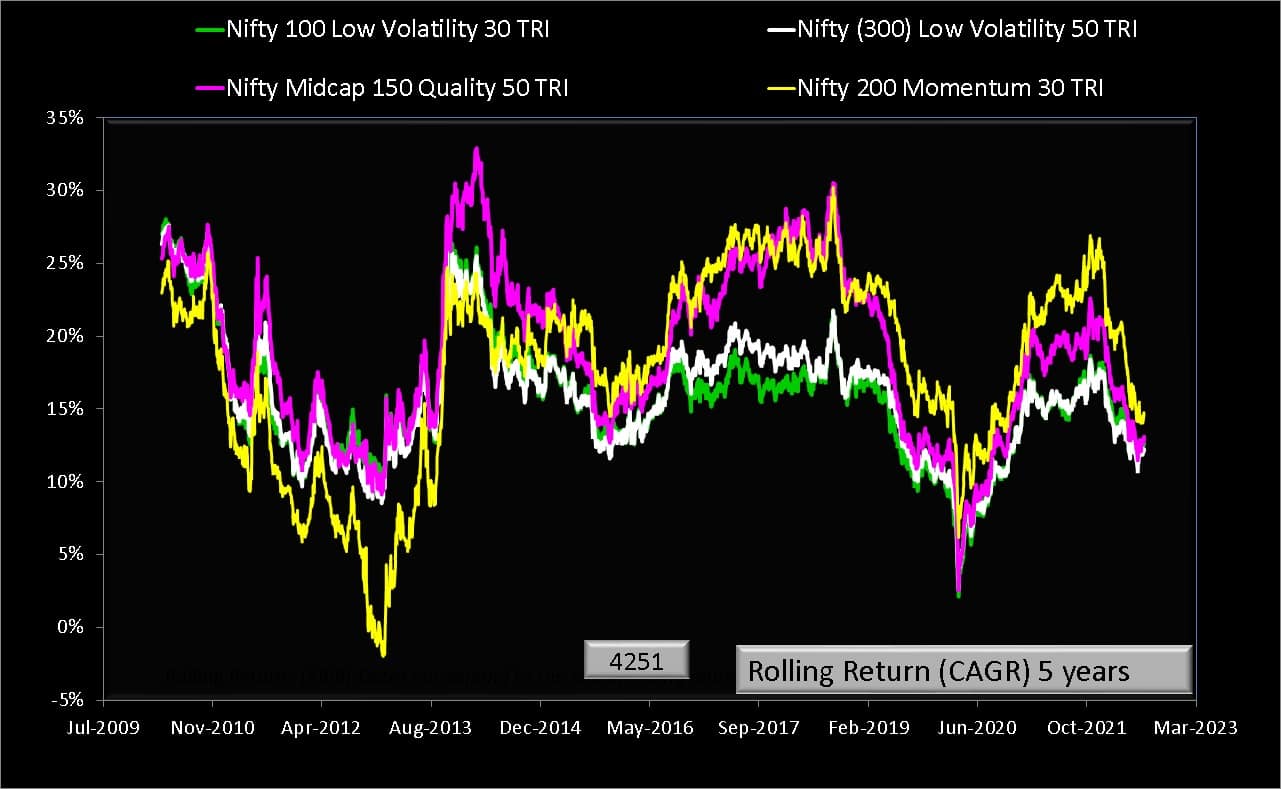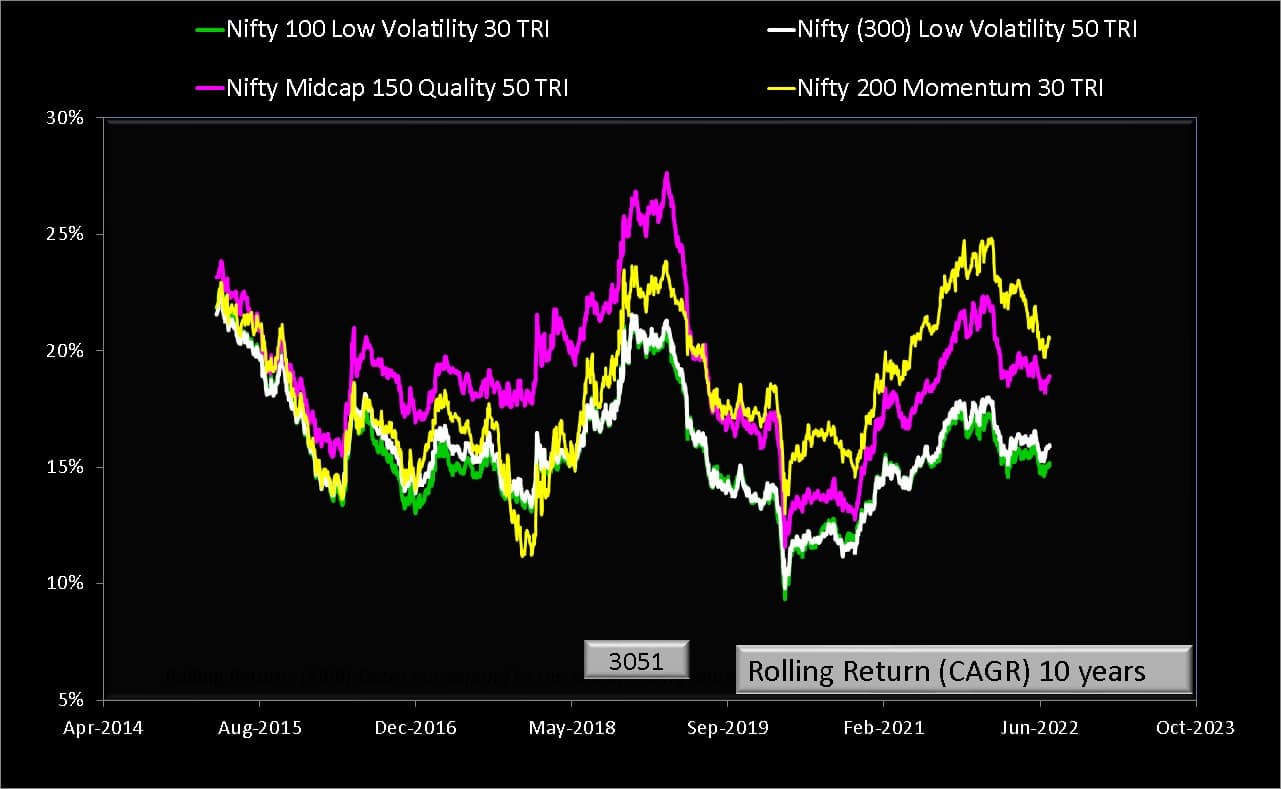Last Updated on September 5, 2022 at 4:16 pm
DSP Nifty Midcap 150 Quality 50 Index Fund is a new offering from DSP tracking the Nifty Midcap 150 Quality 50 Index The NFO period ends July 29th 2022. Should investors consider this? A discussion.
DSP already has an ETF based on this index launched in Dec 2021 with an AUM of 52 Crores. Regular readers may be that we reviewed a similar NFO from UTI in March 2022: UTI Nifty Midcap 150 Quality 50 Index Fund Review.
A factor-based index is one in which parameters like volatility, momentum, alpha, ROE, PB, PE etc., are used to construct the index instead of market capitalization. This is one way to reduce concentration risk in traditional indices like the Nifty and Sensex. This combines active rule-based stock selections with passive investing and is also known as a tilt-weighted index (that is biased to a type of strategy).
While the NIfty 100 consists of the top 100 companies based on full market capitalisation from NIFTY 500, the Nifty Midcap 150 Index represents the next 150 companies (companies ranked 101-250) based on full market capitalisation from NIFTY 500.
Join 32,000+ readers and get free money management solutions delivered to your inbox! Subscribe to get posts via email! (Link takes you to our email sign-up form)
🔥Want to create a complete financial plan? Learn goal-based investing? Exclusive access to our DIY tools? Increase your income with your skills? Use this link to enjoy massive discounts on our robo-advisory tool & courses! 🔥
Construction of the NIFTY Midcap150 Quality 50 Index
The Nifty Midcap 150 Quality 50 Index has 50 stocks with higher profitability, lower leverage and more stable earnings from the Nifty Midcap 150 universe.
According to the methodology document, equal weight is given to return-on-equity (last fiscal year), debt to equity (last fiscal year) and last five-year EPS growth variability. The debt to equity factor is not used for financial services stocks.
For Non-Financial Service sector company:
Weighted Z score= 0.33 * Z score of ROE + 0.33 * – (Z score of D/E) + 0.33* – (Z score
of EPS growth variability)
For the financial services sector:
Weighted Z score= 0.5 * Z score of ROE + 0.5*-(Z score of EPS growth variability)
Here Z scores refer to how much a particular factor deviates from the average value divided by the standard deviation.
The index is weighted by the square root of the free float market cap times the quality score. Each stock can either have a maximum exposure of 5% or five times its weight in the parent index.
It must be understood that this definition of “quality” is arbitrary.
It must also be understood that that Quality index will not always outperform the base Midcap 150 index. For example, an investment in Nifty Midcap 150 Quality 50 on 1st May 2021 would have underperformed a similar investment in Nifty Midcap 150 as on July 19th 2022. So tread with caution!
Regular readers may be aware that we have pointed out twice (Nov 2019 and once in July 2020) that active midcap funds would struggle to beat the Nifty Midcap 150 Quality 50 (NMC150Q30) index: Midcap mutual funds struggle to beat this factor-based midcap index. In fact, we followed this up with another study that shows they have trouble beating the Nifty Midcap 150 index too! Myth Busted: Active mid cap mutual fund managers can easily beat the index.
Our monthly mutual fund screeners
So these are the natural questions we need to answer:
- Can we use DSP Nifty Midcap 150 Quality 50 Index Fund instead of active mid cap funds?
- Can we use DSP Nifty Midcap 150 Quality 50 Index Fund instead of Midcap 150 or Nifty Next 50 passive funds?
- Instead of buying this index fund, can I build a DIY portfolio of select midcap funds based on the index portfolio?
My fascination with factor-based investing has significantly waned thanks to this article: Data Mining in Index Construction: Why Investors need to be cautious. I have now come to appreciate that many of these factors are arbitrary in definition and designed for past outperformance, which may or may not sustain in future.
As we saw yesterday – Should I exit Nifty Next 50 because of Paytm, Zomato and Nykaa? – index curators can happily change the security inclusion criteria at will.
These considerations also apply to DSP Nifty Midcap 150 Quality 50 Index Fund. We can expect a TER of 0.4% to 0.5% for the direct plan, similar to UTI S&P BSE Low Volatility Index Fund (link points to review; disclosure invested) and UTI Nifty200 Momentum 30 Index Fund (link points to review).
Unlike the definition for volatility, there is no universally accepted definition for a “quality stock”. Questions like why the above-mentioned balance sheet metric and not others were used can only be answered by the curator.
Their index construction is arbitrary, to say the least. They have a Nifty 200 Quality 30 and a Nifty Midcap 150 Quality 50. Why only 30 quality stocks from 200 stocks but 50 quality stocks from 150 stocks? Why only factor funds from the mid cap universe? Though it can never be proved, it reeks of backtesting bias.
So the investor interested in this NFO must be aware that the good past performance of NMC150Q30 shown below may or may not sustain in future. The fund expense ratio and tracking error play a role in defining returns, but this cannot be backtested.
NMC150Q30 was launched only in Oct 2019. So much of the history (up to April 2005) is backtested and does not reflect index movement with real-time trading and constituent changes.
Performance of Nifty Midcap 150 Quality 50 Total Returns Index
Over the last ten years, if we consider the 5-year return of the index on any given day, sometimes it has outperformed Nifty Next 50 and Nifty Midcap 150 and sometimes it’s been on par.

The 10-year rolling returns data is better, but notice the time period in the horizontal axis; it is only in the last five years. That is, the history is too short for us to assume that NMC150Q30 will always outperform the other two indices (No, the chart cannot be used as a probability!).

In both cases, the range of possible returns for NMC150Q30 is lower, meaning lower risk as measured by volatility. This can be seen in the 5-year rolling standard deviation graph.

NMC150Q30 has lower volatility than its parent index or Nifty Next 50 and is comparable to that of the Nifty 100 Low Volatility 20 index. This is possibly an indication that “quality mid cap stocks” are relatively more stable”.
Now we shall compare the factor indices.

In terms of 5Y risk spreads, the momentum index is the highest. Next comes NMC150Q30 and then the low volatility indices.
The 10-year rolling returns data tells us no strategy will work at all times! The NMC150Q30 returns dropped dramatically in early 2018 when the midcap segment started falling. Momentum has only outperformed NMC150Q30 in the last couple of years.\

Now let us try and answer some questions. We would like to reiterate that readers appreciate the risks of choosing factor-based funds before reading the following!
Is DSP Nifty Midcap 150 Quality 50 Index Fund a better choice than a Low Volatility Index Fund? (this index is similar in risk/reward to the Nifty 100 Low Volatility 30 index, as shown before)
No. That would be a bit of an apple vs orange comparison as low volatility indices have a large cap tilt (notice 50 low volatility stocks from Nifty 300 are as rewarding as 30 low volatility stocks from Nifty 100). It makes no sense to ask if I can replace a large cap index with a mid cap one.
So then, can I hold both? Yes, but only if you appreciate the limitations of factor indices mentioned above.
Please note: there is no skin in the game for me here. I will not be investing in Nifty Midcap 150 Quality 50 Index Funds for the simple reason it is not required for my circumstances. So please ensure due diligence before investing.
If I had to choose between quality and low volatility, I would choose low volatility because it is a simpler product. The definition of volatility is well established and universal, while the definition of quality is arbitrary. While metrics can be easily added or subtracted to the quality score, it is not easy (at least as far as my thinking takes me) to do this to low volatility without changing the nature of the fund.
Is DSP Nifty Midcap 150 Quality 50 Index Fund a better choice than Momentum index funds?
Again a bit of an apple vs orange comparison (mid cap vs large and mid cap). However, considering that the momentum strategy does not pay as often as it should for the higher risk taken (see 10Y returns), if I have to choose only between these two, I would pick Nifty Midcap 150 Quality 50 Index Fund from UTI or DSP.
Can we use DSP Nifty Midcap 150 Quality 50 Index Fund instead of active mid cap funds?
In addition to the more comprehensive evidence presented above, consider the following. From Feb 1st 2018, to Feb 3rd 2020 (a month before the crash), the mid cap segment kept moving down; only 8 out of 21 actively managed mid cap funds were able to beat NMC150Q30. From 23rd March 2020 (market crash bottom) to 23rd March 2022, 18 of the 24 actively managed mid cap funds beat NMC150Q30.
More importantly, the winners in the first 2Y period are the same as that in the second 2Y period. For example, Mid Cap funds from Axis (the darling of investors before the crash), DSP and Taurus were winners in the first 2Y period but ended up on the losing side in the second 2Y period.
Mid cap funds from Motilal Oswal, Invesco and Tata were comfortable winners in the first 2Y period but just about managed to get into the winning side in the second 2Y period. So there is no guarantee of consistent performance from an active mid cap fund.
If most actively managed mid cap funds cannot beat a ruled-based midcap index during a market downturn, I would rather take my chances with Nifty Midcap 150 Quality 50 Index Fund if I understand the limitations of factor investing and my goal is to beat the Nifty Midcap 150 index after expenses.
Can we use Nifty Midcap 150 Quality 50 Index Funds from UTI or DSP instead of Midcap 150 or Nifty Next 50 passive funds?
Although there is not enough data-based support, and I could well be wrong, I am inclined to say yes to those who don’t mind taking a chance.
We all know how frustrating it is to hold Nifty Next 50. How bad can the mid cap quality 50 funds be compared to that?! Also, Nifty Next 50 funds are only a little less expensive than factor funds (assuming this will also cost about 0.4-0.5%). Again the above-mentioned caveats apply.
Please note: The above is a specific answer to a specific reader question. This does not mean we recommend everyone to stop investing in Nifty Next 50 and shift elsewhere!
Now wrt Nifty Midcap 150 index funds, we have already shown that the tracking errors are large – Not all index funds are the same! Beyond top 100 stocks tracking errors are huge! Even if we expect DSP Nifty Midcap 150 Quality 50 Index Fund to be that bad, the potential lower volatility and higher return is a chance worth taking. Again caveats apply!
Instead of buying this index fund, can I build a DIY portfolio of select midcap funds based on the index portfolio?
This cannot be analyzed or backtested in any way. This route is only suitable for those already investing in stocks and fascinated by mid cap stocks. We do not recommend this for new investors.
All said and done, readers must appreciate that DSP Nifty Midcap 150 Quality 50 Index Fund is a new fund. While the above recommendations may apply to established investors who do not mind investing in an unknown fund, newer investors may wait and watch the tracking error for a few months before deciding.

Use our Robo-advisory Tool to create a complete financial plan! ⇐More than 3,000 investors and advisors use this! Use the discount code: robo25 for a 20% discount. Plan your retirement (early, normal, before, and after), as well as non-recurring financial goals (such as child education) and recurring financial goals (like holidays and appliance purchases). The tool would help anyone aged 18 to 80 plan for their retirement, as well as six other non-recurring financial goals and four recurring financial goals, with a detailed cash flow summary.
🔥You can also avail massive discounts on our courses and the freefincal investor circle! 🔥& join our community of 8000+ users!
Track your mutual funds and stock investments with this Google Sheet!
We also publish monthly equity mutual funds, debt and hybrid mutual funds, index funds, and ETF screeners, as well as momentum and low-volatility stock screeners.
You can follow our articles on Google News

We have over 1,000 videos on YouTube!

Join our WhatsApp Channel



- Do you have a comment about the above article? Reach out to us on Twitter: @freefincal or @pattufreefincal
- Have a question? Subscribe to our newsletter using the form below.
- Hit 'reply' to any email from us! We do not offer personalised investment advice. We can write a detailed article without mentioning your name if you have a generic question.
Join 32,000+ readers and get free money management solutions delivered to your inbox! Subscribe to get posts via email! (Link takes you to our email sign-up form)
About The Author
 Dr M. Pattabiraman (PhD) is the founder, managing editor and primary author of freefincal. He is an associate professor at the Indian Institute of Technology, Madras. He has over 13 years of experience publishing news analysis, research and financial product development. Connect with him via Twitter(X), LinkedIn, or YouTube. Pattabiraman has co-authored three print books: (1) You can be rich too with goal-based investing (CNBC TV18) for DIY investors. (2) Gamechanger for young earners. (3) Chinchu Gets a Superpower! for kids. He has also written seven other free e-books on various money management topics. He is a patron and co-founder of “Fee-only India,” an organisation promoting unbiased, commission-free, AUM-independent investment advice.
Dr M. Pattabiraman (PhD) is the founder, managing editor and primary author of freefincal. He is an associate professor at the Indian Institute of Technology, Madras. He has over 13 years of experience publishing news analysis, research and financial product development. Connect with him via Twitter(X), LinkedIn, or YouTube. Pattabiraman has co-authored three print books: (1) You can be rich too with goal-based investing (CNBC TV18) for DIY investors. (2) Gamechanger for young earners. (3) Chinchu Gets a Superpower! for kids. He has also written seven other free e-books on various money management topics. He is a patron and co-founder of “Fee-only India,” an organisation promoting unbiased, commission-free, AUM-independent investment advice.Our flagship course! Learn to manage your portfolio like a pro to achieve your goals regardless of market conditions! ⇐ More than 3,500 investors and advisors are part of our exclusive community! Get clarity on how to plan for your goals and achieve the necessary corpus no matter the market condition!! Watch the first lecture for free! One-time payment! No recurring fees! Life-long access to videos! Reduce fear, uncertainty and doubt while investing! Learn how to plan for your goals before and after retirement with confidence.
Increase your income by getting people to pay for your skills! ⇐ More than 800 salaried employees, entrepreneurs and financial advisors are part of our exclusive community! Learn how to get people to pay for your skills! Whether you are a professional or small business owner seeking more clients through online visibility, or a salaried individual looking for a side income or passive income, we will show you how to achieve this by showcasing your skills and building a community that trusts and pays you. (watch 1st lecture for free). One-time payment! No recurring fees! Life-long access to videos!
Our book for kids: “Chinchu Gets a Superpower!” is now available!


Must-read book even for adults! This is something that every parent should teach their kids right from their young age. The importance of money management and decision making based on their wants and needs. Very nicely written in simple terms. - Arun.Buy the book: Chinchu gets a superpower for your child!
How to profit from content writing: Our new ebook is for those interested in getting a side income via content writing. It is available at a 50% discount for Rs. 500 only!
Do you want to check if the market is overvalued or undervalued? Use our market valuation tool (it will work with any index!), or get the Tactical Buy/Sell timing tool!
We publish monthly mutual fund screeners and momentum, low-volatility stock screeners.
About freefincal & its content policy. Freefincal is a News Media organisation dedicated to providing original analysis, reports, reviews and insights on mutual funds, stocks, investing, retirement and personal finance developments. We do so without conflict of interest and bias. Follow us on Google News. Freefincal serves more than three million readers a year (5 million page views) with articles based only on factual information and detailed analysis by its authors. All statements made will be verified with credible and knowledgeable sources before publication. Freefincal does not publish paid articles, promotions, PR, satire or opinions without data. All opinions will be inferences backed by verifiable, reproducible evidence/data. Contact Information: To get in touch, please use our contact form. (Sponsored posts or paid collaborations will not be entertained.)
Connect with us on social media
- Twitter @freefincal
- Subscribe to our YouTube Videos
- Posts feed via Feedburner.
Our publications
You Can Be Rich Too with Goal-Based Investing
 Published by CNBC TV18, this book is designed to help you ask the right questions and find the correct answers. Additionally, it comes with nine online calculators, allowing you to create custom solutions tailored to your lifestyle. Get it now.
Published by CNBC TV18, this book is designed to help you ask the right questions and find the correct answers. Additionally, it comes with nine online calculators, allowing you to create custom solutions tailored to your lifestyle. Get it now.Gamechanger: Forget Startups, Join Corporate & Still Live the Rich Life You Want
 This book is designed for young earners to get their basics right from the start! It will also help you travel to exotic places at a low cost! Get it or gift it to a young earner.
This book is designed for young earners to get their basics right from the start! It will also help you travel to exotic places at a low cost! Get it or gift it to a young earner.Your Ultimate Guide to Travel
 This is an in-depth exploration of vacation planning, including finding affordable flights, budget accommodations, and practical travel tips. It also examines the benefits of travelling slowly, both financially and psychologically, with links to relevant web pages and guidance at every step. Get the PDF for Rs 300 (instant download)
This is an in-depth exploration of vacation planning, including finding affordable flights, budget accommodations, and practical travel tips. It also examines the benefits of travelling slowly, both financially and psychologically, with links to relevant web pages and guidance at every step. Get the PDF for Rs 300 (instant download)